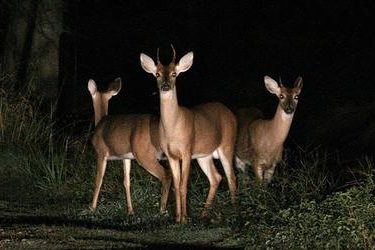AAA warns drivers to be aware during deer season
Beverly Cantrell - October 21, 2021 8:57 am

OKLAHOMA CITY (KOKH) — AAA Oklahoma is reminding drivers that this time of year is when drivers are most likely to strike a deer, which can be both dangerous and, now, more expensive.
AAA advises drivers that October through December is deer mating season, so the animals are more active, which means the animals are more likely to dart into the roadway, which increases the risk of a potential, deadly collision.
The Oklahoma Highway Safety Office says that last year on state roads, 836 crashes involved deer with two people dying and 21 suffering serious injuries.
The Insurance Institute for Highway Safety (IIHS) says that from 2010-2019, almost 2,000 people were killed in animal-related crashes.
With that data in mind, AAA is warning drivers to limit distractions and be on the look out for the animals, especially during the morning and evening hours when deer are most active and most likely to intersect with drivers.
“Safety is priority one, so first and foremost we are encouraging motorists to adjust their driving behaviors to prevent a collision,” says Leslie Gamble, AAA Oklahoma spokesperson. “But they may also want to adjust their insurance coverage because a minor deer strike may mean a major expense.”
AAA Insurance statistics show that the average claim for deer strikes in Oklahoma in 2020 was $5,532 – which is more than $750 higher than in the previous year.
AAA says that driving up the cost of repairs can be partially attributed to the technology in newer vehicles, such as cameras and sensors throughout the vehicle. Previous AAA research indicates that even minor incidents that cause damage to this technology can add up to $3,000 in extra repair costs.
“Deer can be unpredictable so even the best drivers are at risk. Deer collisions can put a serious dent in your wallet if you don’t have a comprehensive insurance policy with adequate coverage,” Gamble adds.
AAA Tips to Avoid an Animal Collision
- Continuously sweep your eyes across the road for signs of animals. While the most likely accident is caused by an animal darting in front of you, one might also run into the side of your car.
- Be especially attentive in the early morning and evening: Many animals, especially deer, are most active during prime commuting hours – roughly 5 a.m. to 8 a.m. and 5 p.m. to 8 p.m.
- At night, use the brights on the vehicle when there’s no oncoming traffic: Your brights can help you spot animals sooner. The light reflecting off their eyes may also reveal their location.
- Slow down and watch for other deer to appear: Deer rarely travel alone, so if you see one, there are likely to be one or more nearby.
- Honk your horn with one long blast: A long blast on your horn may frighten large animals, such as deer, away from your vehicle. The Insurance Information Institute (I.I.I.) advises against relying on devices such as deer whistles and reflectors, which have not been proven to reduce collisions with animals.
- If an animal is in your path, stay in your lane. Swerving away from animals can confuse them so they don’t know which way to run. It can also put you in the path of oncoming vehicles or cause you to crash into objects on the side of the road.
- Always wear a seatbelt. According to the I.I.I, the chances of getting injured when hitting an animal are much higher if you don’t have your seatbelt on.
In the event of a collision with an animal, AAA Insurance recommends:
- If possible, immediately move the vehicle to a safe location, out of the roadway. Your safety and the safety of your passengers is most important.
- Once you are in a safe location and no longer driving, call the police.
- Put the vehicle’s hazard lights on.
- Avoid making contact with the deer/animal. A frightened or wounded animal can hurt you or further injure itself.
- Contact your insurance company as quickly as possible to report any damage to your car.
- Take photos of the damage if you can do so safely and without entering the roadway.



